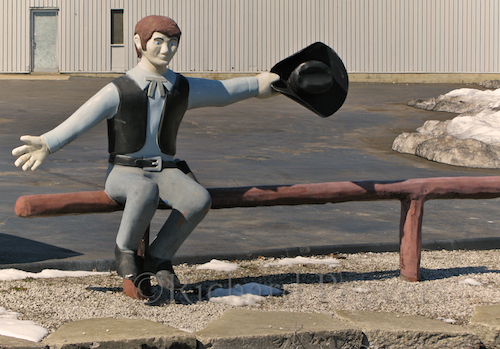One of the biggest curiosities for me as a child was a number of cowboy statues randomly found around West Columbus and surrounding communities. The fiberglass cowboys were nearly identical, except for varying colors in their western wear and bandannas.
These iconic statues were actually part of the branding for Western Pancake House, a chain of restaurants founded by Joe and Lena Skaggs in the late 1960s, which expanded to as much as three dozen locations around the Midwest by the early 70’s.

In 1984, the chain was sold and each cowboy was left abandoned by the roadside, stuck in time and waving their hats to greet younger generations with the mystery of their existence.
One cowboy was privately acquired and found its way to East Palatka, Florida to be used at a location utilized for children’s parties. Two other cowboys in West Columbus now sit outside the present-day businesses of Columbus Auto Resale on Harrisburg Pike and Ari’s Diner on Frank Road.
Another cowboy waves at motorists from private property off of US Route-23 in Southeast Columbus; and one more statue in Alexandria, Ohio has been re-purposed in front of a western apparel store called Wind Song Western World.
One cowboy statue, which no longer exists, found its way to Decatur, Illinois and was customized to dress like a biker and sat on the roof of a discount liquor store. A statue is also known to still exist in Mansfield, Ohio.
Founder Joe Skaggs was born March 30, 1929 in Lowmanville, Kentucky. His family moved to Ohio following the Great Depression in search of work when local coal mines began to close.

After an initial false start in opening a restaurant – a diner called Woodhaven, which he launched near his home in Big Darby Creek – he gave the idea another go, and the Western Pancake House was born. After the second location opened the chain grew exponentially.
The Western Pancake House opened in 10 locations within the I-270 Outerbelt, and then spilled over into five surrounding states. Its popularity grew to support 36 restaurants, and it raced against Bob Evans to become the fastest growing home-style restaurant in the Midwest.
Skaggs said his goal was to franchise 50 locations before he turned 55 years old, according to a 2009 interview with The Columbus Dispatch.
His decision to retire the restaurant chain came after an unexpected heart attack in 1982, coupled with his marriage falling to ruin. Skaggs closed shop, but concentrated his efforts on helping his daughter open a bakery in Hilliard and flipping hot-dog carts to local street vendors.
The franchise experienced a brief resurrection in 2009, when Skaggs opened a new location in Grove City, but this time with no cowboy statue. Early reports of the new restaurant were strong, but the restaurant closed a year later in February, 2010.
Skaggs died on Feb. 5, 2013 at the age of 83 years old.
Update at 10:13 p.m. on Saturday, Nov. 7, 2015
Reader Matt Spangler submitted a memory of his family’s special outings to the Western Pancake House when he was a young child. This is what he had to share:
“When I was a young boy things were much different than they are today. Going out to eat was a privilege that my family only did on Friday nights and Saturday mornings and we used to go to the big Western Pancake House and have breakfast, so that’s how I knew about the statues.
So that was a big deal to me, being able to climb all over the statue after we ate breakfast on Saturday mornings. I also remember my dad always getting packs of matches when we went in. That’s back when you could smoke at the table inside. Things were really thriving at that time on the West Side. Kinda sad it’s not anymore.”
Sean V. Lehosit is a freelance journalist and local history writer. He is the author of Images of America: West Columbus, which was released earlier this year by Arcadia Publishing.
